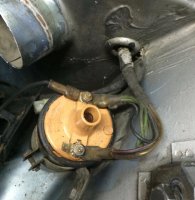I have been progressively refreshing my US 74. New plug wires, new dizzy cap and rotor, new ground cables, making sure I restart the car after each step to make sure there is no problem.
Two weeks ago I installed a Pertronix. Everything went well. We took it for a test drive and the car ran great, much smoother than before.
This weekend I am ready to take it for a spin, it cranks healthily as usual but ... that's it. No attempt for the engine to start. Very puzzling. The car was in the garage and nothing was done to it since I ran great with the Pertronix.
I decided to stick a screwdriver in a plug wire and hold it next to one of the front strut bolts which is a good ground to check for spark. I do get a spark but a weak one. Orange color without much of a crack at all.
So I wonder if the Pertronix has something to do with it. So I remove it and replace it with the points and condenser. Same result. The starter does its job but the engine does not start or even attempt to start.
Then I remembered a couple of odd things I noticed before. I have the original black coil but there is no resistor anywhere I can find. The 74 is supposed to have the wire resistor but it is definitely nowhere near the coil. When I measure the resistance across the coil I get 2 ohms. This is within the Pertronix minimum required resistance I did not worry about it. I also measured the voltage on the coil and it was giving me 7.3 volts. The Pertornix instructions require between 6 and 9 so I figure it was safe to hook it up.
But now that I think back I wonder how a black coil could give me 2 ohms resistance and only 7.6 volts without a resistor. Putting this all together, could it be that the coil is no working properly? Would this explain the low voltage and the weak spark? Should I simply buy a new red coil with the resistor and hope that this was the problem?
Thanks for any help.
Bo
Two weeks ago I installed a Pertronix. Everything went well. We took it for a test drive and the car ran great, much smoother than before.
This weekend I am ready to take it for a spin, it cranks healthily as usual but ... that's it. No attempt for the engine to start. Very puzzling. The car was in the garage and nothing was done to it since I ran great with the Pertronix.
I decided to stick a screwdriver in a plug wire and hold it next to one of the front strut bolts which is a good ground to check for spark. I do get a spark but a weak one. Orange color without much of a crack at all.
So I wonder if the Pertronix has something to do with it. So I remove it and replace it with the points and condenser. Same result. The starter does its job but the engine does not start or even attempt to start.
Then I remembered a couple of odd things I noticed before. I have the original black coil but there is no resistor anywhere I can find. The 74 is supposed to have the wire resistor but it is definitely nowhere near the coil. When I measure the resistance across the coil I get 2 ohms. This is within the Pertronix minimum required resistance I did not worry about it. I also measured the voltage on the coil and it was giving me 7.3 volts. The Pertornix instructions require between 6 and 9 so I figure it was safe to hook it up.
But now that I think back I wonder how a black coil could give me 2 ohms resistance and only 7.6 volts without a resistor. Putting this all together, could it be that the coil is no working properly? Would this explain the low voltage and the weak spark? Should I simply buy a new red coil with the resistor and hope that this was the problem?
Thanks for any help.
Bo


